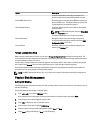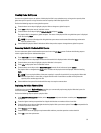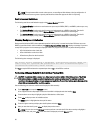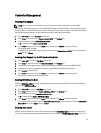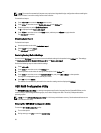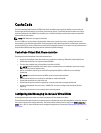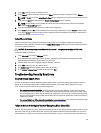
CacheCade Virtual Disk Management
The Virtual Disk Management screen is the first screen that is displayed when you access a RAID controller from the
main menu screen on the BIOS Configuration Utility.
The following are CacheCade-related actions you can perform through the virtual disk management menu:
• Create CacheCade virtual disk
• Assign CacheCade virtual disk name
• Delete virtual disk
Creating CacheCade Virtual Disks
NOTE: Only SSDs can be used to create CacheCade virtual disks.
NOTE: Combining SAS and SATA SSDs within a CacheCade virtual disk is not supported.
NOTE: To avoid inefficient use of space, it is recommended that CacheCade volumes are created with drives of the
same size. Larger disk sizes are truncated to the size of the smallest contributing disk, similar to RAID 0.
To create a CacheCade virtual disk:
1. During host system bootup, press <Ctrl> <R> when the BIOS screen is displayed.
The Virtual Disk Management screen is displayed. If there are more than one controller, the main menu screen is
displayed.
2. Select a controller, and press <Enter>.
The Virtual Disk Management screen is displayed for the selected controller.
3. Use the arrow keys to highlight Controller #.
4. Press <F2>.
The list of available actions is displayed.
5. Select Create CacheCade Virtual Disk and press <Enter>.
The Create CacheCade Virtual Disk screen is displayed. The cursor is on the first SSD listed in the Select SSD
section.
6. Select the desired SSD(s). As each new SSD is selected, the CacheCade Virtual Disk Size changes to reflect the
new size.
NOTE: You cannot specify the size of the virtual disk.
7. Press <Tab> to move the cursor to the CacheCade Virtual Disk Name field. Enter a name if required.
8. After you specify the virtual disk name, select OK to save the selection or select Cancel to cancel the selection.
After the CacheCade virtual disk is created successfully, it is listed in the Virtual Disk Management screen under
the CacheCade disk group, and is labeled as a CacheCade virtual disk. The virtual disk has an optimal state and its
RAID level is RAID 0.
NOTE: You can only delete or rename a CacheCade virtual disk. Background initialization, fast initialization, full
initialization, and consistency check operations are not applicable to CacheCade virtual disks.
62



